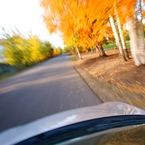 However experienced a driver is, there will be times when bad weather or other factors will make road conditions more dangerous and they’ll find themselves in a position where their car suffers a loss of traction. This can quickly cause a loss of control and increase their risk of their becoming involved in an accident. In addition to the effects of snow, rain, and ice, oil and other spillages can reduce the grip between a car’s tires and the road surface. It’s important for drivers to understand what to do if their car loses traction. Read on for tips from our team at DCH Audi Oxnard.
However experienced a driver is, there will be times when bad weather or other factors will make road conditions more dangerous and they’ll find themselves in a position where their car suffers a loss of traction. This can quickly cause a loss of control and increase their risk of their becoming involved in an accident. In addition to the effects of snow, rain, and ice, oil and other spillages can reduce the grip between a car’s tires and the road surface. It’s important for drivers to understand what to do if their car loses traction. Read on for tips from our team at DCH Audi Oxnard.
Braking
An instinctive reaction of most drivers when their car loses traction and begins to slide out of control is to apply the brakes. However, even when the vehicle has anti-lock brakes, this response is likely to make it harder to regain control of the car. Reducing speed by taking your foot off the accelerator will be far more effective as a means of improving the traction of the car, and it’s less likely to increase the risk of an accident.
Another method of improving traction is to change your gear to a lower setting. By increasing the level of deceleration, this will improve traction by reducing the speed of the car. However, with the increased differentiation between gearing ratios in automatic gearboxes, this approach may not always be advisable. Nonetheless, a gradual reduction of speed, rather than the aggressive reduction resulting from braking, will be more effective in terms of regaining control of your car and improving its level of road traction.
Steering
When a car loses traction, it’s natural for a driver to turn the steering in the opposite direction. Again though, this can easily increase the loss of control of the car. The effective approach to steering if your car loses traction is to turn the steering wheel in the same direction you are already moving.
Awareness and driver behavior
Finally, awareness and adaption of driving behavior are important elements. The impact of bad weather conditions on road traction is likely to be more prevalent in rural and freeway areas, which have less protection from the elements. To reduce risk while travelling on these roads, it’s important for the driver to adapt his or her driving to reflect the conditions – for example, by lowering speed and increasing distance from the car in front.



